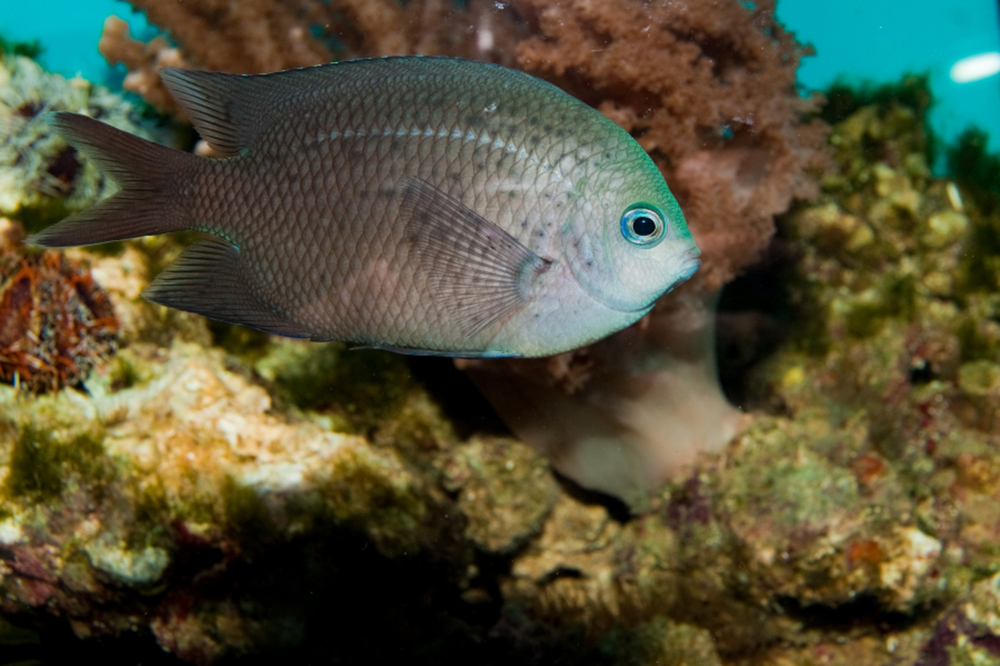May 2022 | Volume 23 No. 2
Rapid Response
Increased ocean acidification (OA) in recent decades means that pH levels in the global oceans are predicted to decline to levels which may affect some marine fish. Knowing how it will affect growth, behaviour and even survival of various types of fish is essential to working out how to optimise their conservation and management.
Dr Celia Schunter at HKU’s School of Biological Sciences and the Swire Institute of Marine Science, led the study, working with teams of researchers from Japan, Australia and New Caledonia in the natural laboratories of Papua New Guinea.
“The most important discovery we made,” said Dr Schunter, “is that the difference in evolutionary rate (over millions of years) provides the fish which evolved more rapidly with the flexibility to acclimatise. They can rapidly adjust the expression in a larger number of genes, which provides certain species with an ability to respond to the environmental changes such as elevated pCO2 [partial pressure of carbon dioxide].”
The team carried out their research in Papua New Guinea’s Upa-Upasina seep. “Volcanic CO2 seeps in Papua New Guinea can be used as natural laboratories, where CO2 rises from the substratum and acidifies the surrounding seawater to levels similar to, or sometimes beyond, the projections for OA by the end of this century,” said Dr Schunter. “Despite these ‘future’ conditions, many species still live in these seeps and studying them can allow us a peek into future ecosystems.
“While previous studies investigated the molecular response to elevated pCO2 in different species, these investigations were performed in controlled aquarium systems. This study is the first of its kind to compare across species in a natural setting.”

A. polyacanthus may possess evolved molecular toolkits to cope with future ocean acidification.
Storm sparks discovery
Nature also provided their work with another boost when a heavy storm rapidly changed the pH levels in the seep. “The storm brought many difficulties for sampling and complicated the field work,” said Dr Schunter. “But, at the same time, it also provided us with key evidence of the flexibility of the spiny damselfish species A. polyacanthus to adjust to pH changes.”
In particular, A. polyacanthus lacks a larval dispersal phase, which leaves this species with a more pressing need to adapt to local conditions than species with a dispersive larval phase. “We see this as the species has many positively selected genes across its genome, which means that selective processes are at play to adjust its genome to better live in local environmental conditions,” said Dr Schunter.
“Maintaining pH and ion transport homeostasis are key challenges for fishes when coping with elevated pCO2. This fish can adjust the expression of core circadian rhythm genes, which regulate the expression of the downstream gene related to intracellular pH regulation and ion transport.”
Circadian rhythms are near-24-hour oscillations found in nearly all aspects of physiological processes in the vertebrate brain and body. The circadian clock also runs our daily lives and adjusts our metabolism to the time. Dr Schunter explained that you know the circadian rhythm is at play when you get tired in the evening or get hungry around the same time each day.
In short, she said, A. polyacanthus has developed a molecular toolkit, which will enable it to cope better with pH variations. “Previously we didn’t understand why some species struggle with OA more than others. This time we saw that A. polyacanthus can regulate the pH levels within its cells through the gene expression changes in response to the environmental elevated pCO2 at the CO2 seep. We originally thought that an elevation in the pCO2 to end-of-century predictions would not be a large impact to fishes, as they know how to regulate the pH, however we see that these coral fish species induced significant expression changes in many genes. This underlines the need to regulate the cells in the brain in response to the CO2 levels in the ocean waters.
Reversible changes
The arrival of the storm, which lasted 24 hours at the remote reef, moved a lot of water of the CO2 seep site and increased the pH temporarily. “We were able to collect some spiny damselfish during this time and now see that all the cellular changes are reversible as they changed quickly back to the levels of what we see at the control reef with current-day CO2 levels.”
However, although this particular species has coping mechanisms there is still cause for alarm at the pace of OA. Rapid environmental changes – caused by humans – are a threat for fishes, especially for slowly evolving fish species, said Dr Schunter. “Even for A. polyacanthus, it can be a problem if the environment changes faster than its ability to regulate the cellular activities. As such, it’s important for us humans to slow down the activities which accelerate the environmental changes.”
The research continues with further studies underway. “These include other fish species from different ecosystems (but also from CO2 seeps) to understand the general applicability of our findings across all marine ecosystems (not just coral reefs),” she said. “Furthermore, as the circadian rhythm clearly plays an important role in the adjustment to changes in pH in fishes, we will investigate further the mechanisms and adaptive potential underlying this.”
The storm brought many difficulties for sampling and complicated the field work. But, at the same time, it also provided us with key evidence of the flexibility of the spiny damselfish species A. polyacanthus to adjust to pH changes.

DR CELIA SCHUNTER

